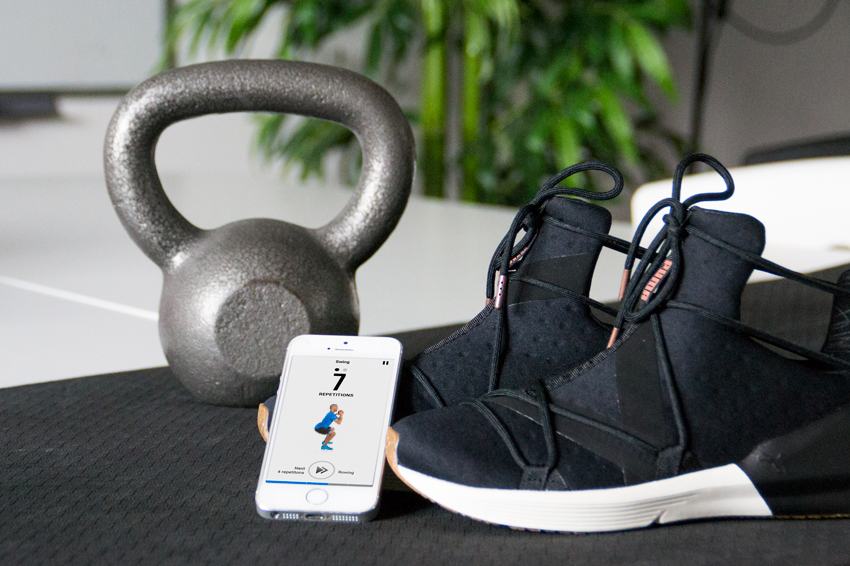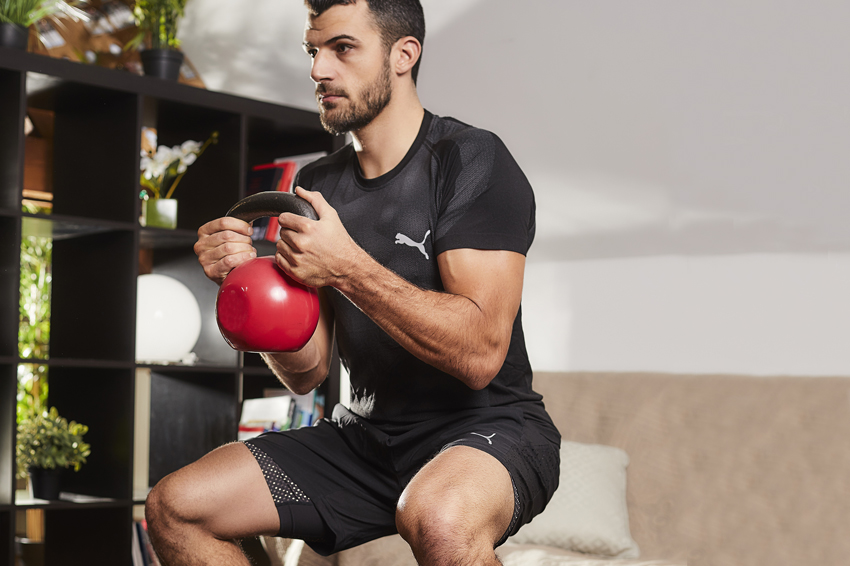The goblet squat is a movement used to teach beginners the basic technique of the squat, so why not take advantage of it to improve your overall approach to this exercise. You’ll find this highly effective variation in one of FizzUp’s Challenges*, but just because it looks easy, doesn’t mean there aren’t a wide range of mistakes to avoid for a more optimized workout. Now that you know what you shouldn’t be doing when you do pull-ups, kettlebell swings, crunches, planks and burpees, the FizzUp trainer is bringing you the top five mistakes you could make with the goblet squat and what to do about them to help you safely reach your goal with this exercise as part of your workout routine.
If you’re pushing on the balls of your feet and lifting up your heels when you do a goblet squat, this puts unnecessary pressure on your knees, weakening your stance and balance because you have less contact with the floor. This is one mistake that can result in more injuries and fewer results, especially when you’re lifting a weight.
FizzUp trainer’s tip: While doing a goblet squat with or without a kettlebell, you need to keep your heels firmly on the floor. This technique one of the keys to activating the right muscles when you do a goblet squat (your glutes, quads and abs), increasing joint stability, keeping your balance and maximizing your potential strength. To keep yourself from lifting your heels, you should use stretching to improve your hip and ankle mobility. When you do a goblet squat, you also need to be pushing through your heel using your entire foot, instead of putting your weight on the ball of your foot.
Doing a partial goblet squat will never be as effective as doing a goblet squat with a full range of motion. Ideally, you should squat down until your hip joints go below your knee joints, without arching your lower back to make your repetition actually “count” toward your progress. This puts your glutes and other leg muscles to the test and helps you perfect the movement from start to finish. These two factors stimulate your muscles and nerves to the max: the winning combo for results with this exercise.

FizzUp trainer’s tip: Again, in order to do a deep goblet squat while keeping your lower back straight, your hips and ankles need a certain level of flexibility. If you want to improve your technique, focus on using the right range of motion while keeping your entire body solid and engaged. And don’t forget to make stretching a part of your daily routine (check out FizzUp’s Single Workouts!). Bend your knees while holding the kettlebell firmly against your body to keep yourself balanced. Over time and with the help of proper stretching, you’ll widen your range of motion until you’re able to do a true goblet squat. As an alternative, you can also try the box squat with a kettlebell. Just stand in front of bench, table or chair that’s low enough to give you a rather wide range of motion but isn’t so low that you feel like you’ll fall backward. This will show you how much your range of motion has improved.
This mistake is bad for your knees and significantly increases your risk of injury. What’s more, a moving joint doesn’t easily transfer strength. In essence, you need to avoid pointing your knees inward (like valgus knee) at all costs. There are several reasons why this can happen:
FizzUp trainer’s tip: After you’ve checked to make sure your shoes aren’t holding you back and you’ve gradually started to add stretching to your daily routine, you need to start examining your technique. Your knees should stay aligned with your toes, which are pointed outward slightly when you do a goblet squat. This will give you more room to bring your hips into a deep squat position. Push away from the floor using your feet to lift your body and push on the outsides of your feet as you lower it. When you come back up, repeat the movement and engage your glutes.
If you repeatedly point your pelvis backward and tuck it under your torso when you get to the lowered position during a goblet squat, over time this can lead to severe lower back pain.

FizzUp trainer’s tip: All too often, this happens due to a lack of clean technique and low hip and ankle mobility, which are both factors that can cause you to hunch your lower back while doing a goblet squat with too wide a range of motion. Start by doing squats over a low stool (like a box squat) or reduce your range of motion to the point where you can still keep your back straight. Your hips should be tilted forward rather than backward. Remember to stretch your hip flexors, too, which are often extremely stiff if you spend a lot of time in a seated position. Sadly, this is the case for many people nowadays, making it hard for them to master the perfect goblet squat in addition to having negative effects on your back and general health.
As you lower your body, don’t lean forward and hunch your back, especially the lower part. This major slip-up in your technique keeps you from using a full range of motion and puts a significant amount of pressure on your spinal discs. In most cases, this happens because your hips aren’t flexible enough, you’re not engaging your core or your kettlebell is too heavy.
FizzUp trainer’s tip: You need to be consciously engaging your abdominal wall and holding the kettlebell or dumbbell against your stomach to keep it stable. Act like you’re going to sit on a chair. Don’t lean forward. Then, place something solid under your heels to solve any ankle mobility problems while you’re working to improve their flexibility with the right stretches. These problems also come about because of stiffness in your pecs, neck and the middle (thoracic) part of your spine.
You can count on the FizzUp trainer to share all his secrets for the perfect goblet squat and tips for FizzUp workouts that rock. Read up to get the most out of your “Build Muscle with Equipment” program* now!
*FizzUp PRO feature
Join the 7 million users already registered on FizzUp
Join us